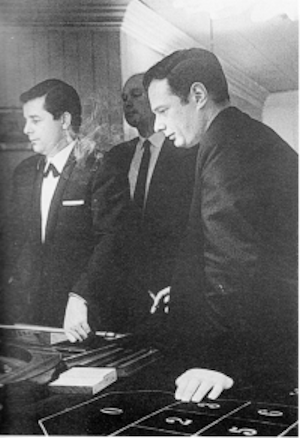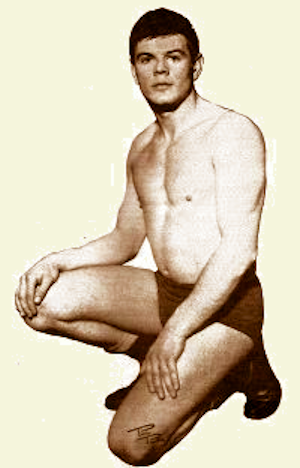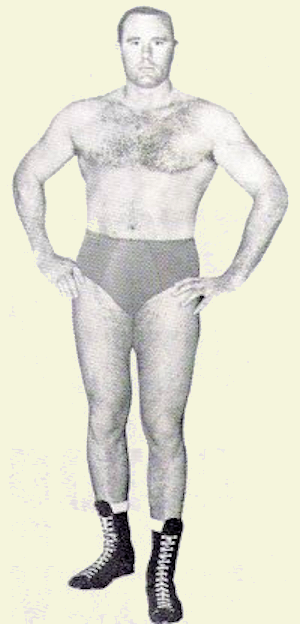2011-03-27
The Wrestling Beatle

Life, my dear sistren and brethren, is not like a box of chocolates, except perhaps those from the exclusive and exquisite Tartufo shop in Louvain. Life is like an Eskimo chain, tattooed all over our brains. When the Reverend started the Church he didn't realise what a strange caterpillar ride it would be, a beautiful quest into the unknown. The path we trod was narrow, the drop was sheer and very high and ravens were watching from a vantage point nearby, to paraphrase a great poet.
On the narrow paths, that Iggy had followed in the past, she had thrown breadcrumbs to find her way back home afterwards. Only Iggy never returned on her footsteps but went far ahead into the unknown. Most of these crumbs had long been eaten, by the ravens cited above, but some could be traced back by the Church. And one big trail lead to the Cromwellian club.
The Cromwellian wrestling club
Before it acquired its fame the house at 3 Cromwell Road was known as an illegal casino, run by the London underworld. When gambling became legal the three store building turned into Harry's International Bar (run by the legendary Harry Heart), an elegant casino (quickly moved to the first floor because some competitors wanted to heat the place with Molotov cocktails) and a cellar full of boys, much to the enjoyment of the bartender, but the management decided to repair the equilibrium by giving 'free entrance for girls'.
Before one could say 'faites vos jeux' the place was visited by Brian Epstein and his gang of four and that perhaps thanks to one of the owners who was nicknamed 'the wrestling Beatle'.

Bob 'Anthony' Archer
Bob Anthony (Bob Archer), the wrestling Beatle, was a popular welterweight during the 1960s and may not be confounded with the slightly ridiculous George Ringo (Bob Sabre), a Chicago wrestler who had the same nickname. Bob turned professional in 1956 and around 1962 he moved to Paul Lincoln Management. He was one of a group of wrestlers chosen by Paul Lincoln to take part in a prestigious tour of the Far East in the early sixties.
But, like we have already revealed in our article Dr Death and other assorted figures..., he was also one of the owners of the Crom and, what the Reverend didn't know, responsible for booking the bands that would make the place a legend.
Recently the Church was contacted by Emily Archer and thanks to her we can bring you the following testimony from her father:
I was part owner and manager of the Crom up to 1967 when I gave up the management, but not my share, to create Pantiles Club and Restaurant in Bagshot.
The Pantiles Club was built in 1898 for the personal secretary of the Duke of Connaught who lived at the Royal Bagshot Park opposite. During the 1920s there was a Pantiles Athletic & Tennis Club, followed by a Pantiles Swimming Pool Club. In the early 1960s a Pantiles Tea Dancing Club was opened and in 1967 it would become the infamous Pantiles nightclub and restaurant owned by Bob Archer.
I was also a Pro Wrestler as Bob Anthony. There were 4 of us wrestlers involved - who were also 4 good friends, plus the originator of the Cromwellian Tony Mitchell. Ray Hunter, Judo Al Hayes, Paul Lincoln. Al died in the States where he wrestled as Lord Hayes, Ray died also in the U.K. My great friend Paul Lincoln died recently. Paul and Ray also owned The 2'Is in Old Compton Street, where the whole British Rock industry emerged from.

Judo Al Hayes
Judo Al Hayes, alias the White Angel, alias Lord Hayes once was the the nation’s youngest ever judo black belt. He hooked up with Paul Lincoln and had a fun run as the White Angel, culminating in a famous 1962 fight were he was unmasked by Doctor Death (Paul Lincoln with a mask).
In the early seventies Hayes went to the United States. After a successful career as a wrestler he became a television commentator and manager for the American Wrestling Association.
After a car accident he suffered from several complications and died a very sad death in 2005, aged 77.

Rebel Ray Hunter
Rebel Ray Hunter, Taswegian tag partner of Judo Al Hayes in their Lincoln days, and a globe-trotting Heavyweight Champion of the Commonwealth. When Hunter came to Britain in 1950 he had been the youngest Commonwealth wrestler to do so. Success came in German heavyweight tournaments but the sixties saw a hedonistic jet-set lifestyle in Soho where Hunter and Lincoln owned the famous 2'Is coffee bar.
Rumour goes Hunter had a fling with Sophia Loren once.
Around 1970 he disappeared mysteriously from the wrestling scene.
2I's
The bar 2Ii’s was located at 59, Old Compton Street. Underground legend Barry Miles remembers:
At the 2I’s we sat drinking coffee from glass cups, staring out at Old Compton Street, thinking this was the centre of the world as Dream Lover by Bobby Darin played on the jukebox and various sleazy Soho types drifted in and out. It had opened early in the summer of 1956.
Compared with the other coffee bars in Soho, the 2I’s looked pretty tame. Just round the corner on Meard Street was Le Macabre, which used coffins as tables, Bakelite skulls for ashtrays and the jukebox featured the Funeral March. The 2I’s had been open three weeks when Soho held its second annual Soho Fair, to coincide with the July 14, 1956, Bastille Day celebrations. The Vipers skiffle group were among the bands in the procession. When a downpour made them jump down from their flatbed truck and take refuge in the 2I’s, the nearest coffee bar, Paul Lincoln suggested they continue playing there. Immediately a large crowd came in from the street.
Paul Lincoln realised that live music was what was needed to pull in the customers and hired them to play a regular gig from 7 to 11pm, four nights a week. At first they were paid only in spaghetti, Coca-Cola and any tips they were able to collect, but their leader Wally Whyton soon decided that a proper fee was required as the place was crammed to its 80-person capacity every time they played. Paul Lincoln made a derisory offer and Wally, bravely, said he would wrestle him for double or nothing. Lincoln was impressed by his guts, strapped on his Doctor Death mask and lost the fight hands down, presumably intentionally. The Vipers got their wages. (Taken from: Going underground: the secret life of London.)
Food and drinks
Le Macabre coffee bar was not unknown to the wrestlers either and was owned by someone they knew. Bob Archer:
Le Macabre Coffee Bar was in fact owned by Tony Mitchell who was the original owner of the Crom until we bought in with him. He also had a restaurant called the New Yorker in Soho. Al Hayes, Ray Hunter and myself would meet for lunch at his restaurant before going on to wrestling engagements or sometimes before training at the YMCA.
Later Paul Lincoln and Ray Hunter also opened The "Trattoria del buon vivitore", an Italian restaurant in Old Compton Street with the Wrestling Promotion Office above.
In a previous article (Dr Death and other assorted figures...) we already mentioned that Paul Lincoln owned an Italian restaurant in Soho. What we didn't know was that the place was just a few blocks away from 2I's (56 Old Compton Street) and located underneath the Paul Lincoln Management offices (36 Old Compton Street). No wonder that Paul Lincoln often took his business associates to the place and even a top ranking Milanese police officer, who Lincoln had befriended during an Italian wrestling showtour, always visited the restaurant whenever he was in London for police business.
The Crom
Bob Archer continues:
Tony [Mitchell] is long gone so I am the only remaining ex owner. I ran Pantiles from 67 to 2007, 40 years, till we sold the land. I was the one who originally created the Swinging London status of the Crom and the 60's celebrity hangout of the stars.
I booked the right bands, and encouraged the sit in sessions, with The Animals, Clapton, Hendrix, and you name it. Elton's band Bluesology were probably my most regular booking, plus Brian Auger. The Drifters, Patti LaBelle, Stevie Wonder, Wilson Picket, Benny King.
They all worked in that small cellar. Harry Heart [the bartender] was a legend. I could go on all night. True fact is the first place Jimi [Hendrix] played in London was The Crom. He sat in with Brian Auger. Chas [Chandler] brought him in the first night he arrived. Kathy [Etchingham] worked a bit for me.
Jimi Hendrix
The Jimi Hendrix Record Guide has an interview with Brian Auger about Hendrix's first London gig on the fifth of October 1966:
JHRG: Are you sure the first jam was at The Cromwellian?
Brian Auger: It was The Cromwellian, yes.
JHRG: Some say it was Blaises, and I think Vic Briggs said he was convinced that it was The Scotch Of St. James!
Brian Auger: Yeah, but it wasn't. I'm afraid Vic kind of rewrites history a bit, (chuckles) but it wasn't The Scotch Of St. James, it was The Cromwellian. I have a mental picture of Jimi being introduced to me and looking out across the stage at the staircase that goes up from upstairs to the first level of The Cromwellian. We definitely played at Blaises but that was later.
Anyway, he came down to The Cromwellian and Chas [Chandler] introduced him to me in the break and he seemed like a very nice guy. He asked me if he could sit in and I said absolutely, yeah, what would you like to play? Jimi showed me a chord sequence and said, can you play this? And I said yeah, it's pretty straight forward, and it turned out to be the chord sequence for "Hey Joe"!
And all that thanks to a cellarful of wrestlers.
Harry the Heart
The bartender of the 'International Bar' was, to put it in Rod Harrod's words the “very camp 'Harry the Heart'”. Heart wasn't his real name but came 'from his delightfully effeminate wave over the heads of a packed bar as you walked in: 'Hello (dear) Heart, how are we? Be with you now.'"
Unfortunately, not a lot is known about him. Bob Archer:
The last time I heard, Harry was in North, but that was a long time ago, from Danny La Rue [the famous British drag impersonator]. I fear that he has passed away. He was amazing. His bar was always full with people like Tom Jones with his band, Brian Epstein, Lion Bart, Terry Downes, Lita Rosa, Robert Stigwood. I could go on and on...
A bartender can make or break a place but Harry is surely remembered as one of those extraordinary people who turned the place into a succes.
He knew what everyone drank, and asked "Your usual Heart?"
They would say: "Yes Harry and will you have one?"
Harry then replied: "Just one for the pot Heart."
This inevitably turned into Harry's own little ceremony, serving a glass of gin he would...
...throw another gin into the cut glass vase that he had on the bar, with bits of lemon and cucumber floating about in it.
Bob Archer has nothing but lovely memories about Harry:
He would introduce me to all his friends as "My lovely Boss". We would often go for a burger after closing, unless he said "I'm trolling tonight Heart" and would then walk up past Harrods.
Keith Goodwin
Rod Harrod, the club's PR man and interviewed by the Church as well, wasn't the first journalist who had been hired to promote the club.
I have been trying to remember who was Rod Harrod. The name rings a bell, but the guy who I used as PR was Keith Goodwin, who had his column in either the MM or the NME, where we were regularly mentioned. He was also PR to quite a few music stars.
Keith Goodwin was indeed an NME journalist in the early sixties and one of the first professional music publicists in the UK with a diverse, even oddball, taste in music.
He started his agency with folk band The Springfields (it is eerie how Dusty materialises every time we investigate Church matters) and Tom Springfield was best man on his wedding.
But it was when psychedelia fully hit the scene that Goodwin acquired the most success for his publicity work. Amongst his clients were – initially obscure bands like - Argent, Black Sabbath, Camel, Magma and Yes. One day in 1966 a young singer songwriter, Cat Stevens, was in his office, looking for an appropriate title for a tune he had just written. Keith Goodwin looked out of the window and suggested the name of the shop at the other side of the road: Matthew And Son.
His love for symphonic rock wouldn't falter although the genre was declared dead in the late seventies, early eighties. He continued promoting bands like Pallas, Twelfth Night and Pendragon but it was with Marillion that he could finally prove that the progrock genre still attracted massive popularity. In 1988 Keith Goodwin retired and settled in Malta. He died on the 25th of January 2004, only 69 years old. (Taken from: Keith Goodwin: early professional music publicist.)
Many thanks to Emily and Bob Archer for sharing these memories with the Church. Wrestling information and pictures have been taken from Wrestling Heritage. Grazie mille Gianna!
Update August 2011: Paul Lincoln, better known as Doctor Death, sadly passed away in January 2011 (RIP Paul Lincoln). In July 2011 he was awarded The Number One Masked Man of the Heritage Years by the Wrestling Heritage website.
More to read and watch:
A 1962 movie The
Wrestling Game (Part 1 & Part
2) has Rebel Ray Hunter and Judo Al Hayes.
Wrestling
Furnace has articles and pictures of Dr.
Death, pictures
from Rebel Ray Hunter and a 1971 Judo Al Hayes article.

